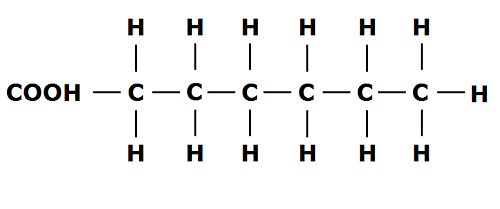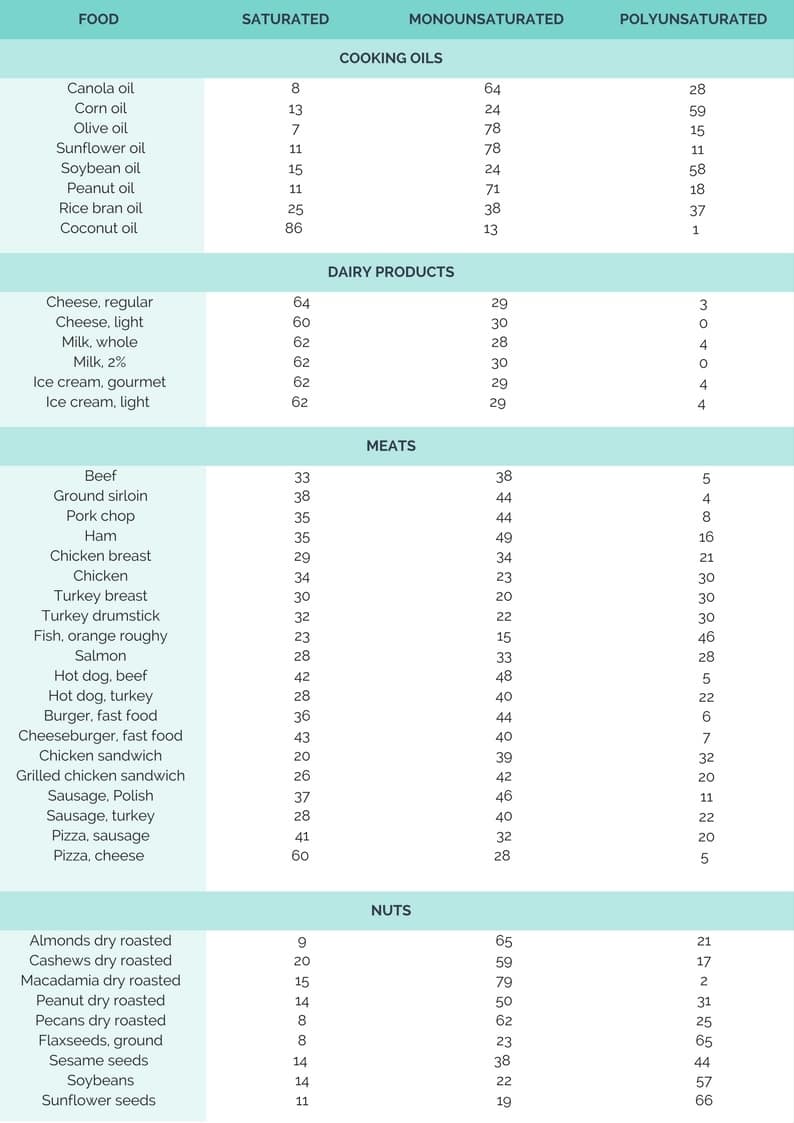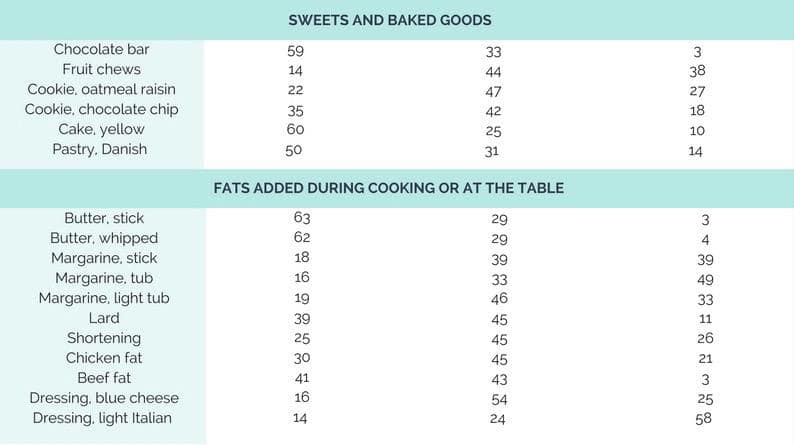By having that deeper understanding of how the basics of nutrition work, we can not only provide more focused help to our clients, but also provide ourselves a foundation for learning more advanced information.
In this article we will look in detail at fats, their structure, how they work within the body and the benefits they can provide.
Before digging in, as a valued reader of the blog, I’d like to extend you an invitation to our upcoming and totally FREE online training workshop:
‘The Proven Nutrition Strategies of Elite Trainers’.
This workshop is for you if you want to finally learn the best nutrition protocols and evidenced-based strategies to help your clients achieve life-changing results.
This workshop is our most complete training on how to make nutrition coaching easy and profitable.
All you need to do to attend is click here to register your free spot.

The Fat Myths
Our acceptance of fats has come a long way over the recent years, and the latest research surrounding them have mainly driven this. In just a few short years the majority of us, including fitness professionals and athletes, can usually come to some agreement that specific fats in sufficient amounts can benefit body composition and health. (1) (2) (3)
Just like with other macronutrients, it is the amount and specific type of fat we should eat that needs to be understood. (4)
Health authorities are accepting this change too, and we are being encouraged to increase our daily intakes in place of refined carbohydrates.
Out of all the macronutrients, fat still seems to be the least understood, and a vast majority of people will have difficulty believing a high fat low carbohydrate diet may be the answer to their nutrition problems.
This is to be expected, as most government and academic sources have not condoned fat in the diet. Therefore, as nutrition coaches, it’s important to understand the underlying chemistry of fat, its vital functions, how it is metabolized and to understand the latest research.
Fat is also known as ‘lipids,’ which provides a collective name to a wide variety of water-insoluble chemicals, including all fats and oils in the diet and body.
Similar to protein and carbohydrates, fat is made up of carbon, hydrogen, and oxygen, but the main difference is that the ratio of oxygen to the other molecules is lower.
This results in fat being a more concentrated source of energy for the body and 1 gram of fat provides around nine calories (compared to four calories per gram for protein and carbohydrates).
Fat Types
Fat, or lipids can be broken down further, so let’s examine the various fat types and their definitions:
Triacylglycerol or triglycerides (TG’s)
The TG’s are a glycerol ‘backbone’ molecule composed of three fatty acid chains. This is the most nutritionally significant fat as they are the main source of ingested fat and provides the majority of energy derived from dietary lipids. 1 gram of TG’s provides 9 kcal per gram of energy.

Triacylglycerol Molecule
Glycerol (or glycerin)
Glycerol is a three-carbon molecule that is part of the large TG’s molecule (serves as the backbone). Glycerol by itself is a three carbon ‘sugar’ that when released from storage, can be recycled in the liver for the creation of new blood sugar. This process is known as ‘gluconeogenesis.’
Fatty acids
There are three major types of fatty acids. Their molecular bonds and the number of hydrogen atoms they contain distinguish these three types from one another.
Fat may be saturated, monounsaturated (possessing one carbon-carbon double bond) or polyunsaturated (having two or more carbon-carbon double bonds).
We can then break this down further:
Saturated fat: is a lipid that consists of triglycerides containing only saturated fatty acids. This means all available carbon atoms are occupied (saturated) by the hydrogen atom, unlike unsaturated fat. This makes them the most stable and least likely to turn into free radicals when exposed to heat, oxygen or light. This is why it is suggested to cook with these types of fats, so think grass-fed butter or coconut oil. (5)

Saturated Fat Molecule
While nutrition labels regularly combine the various saturated fatty acids, they do appear in different proportions among food groups. Lauric and myristic acids are most commonly found in ‘tropical’ oils or dairy products. Saturated fat in meat, eggs, and nuts is primarily the triglycerides of palmitic and stearic acids.
The table below shows the saturated fat profile of common foods with fatty acids as the percentage of total fat:

Polyunsaturated Fat
Polyunsaturated fat are triglycerides in which the hydrocarbon tails constitutes polyunsaturated fatty acids (PUFA’s), i.e., fatty acids possessing more than a single carbon-carbon double bond.
‘Unsaturated’ refers to the fact that the molecules contain less than the maximum amount of hydrogen, thus making them more unstable compared to saturated fats.
From what we eat, we get two types of polyunsaturated fatty acids, linolenic acid (omega 3 fatty acid) and linoleic acid (omega 6 fatty acid).
Monounsaturated Fat
Monounsaturated fats are triglycerides that have one single carbon-carbon double bond in the fatty acid chain, and all the other carbon atoms are single bonded.
Monounsaturated fat has a higher melting point than polyunsaturated fatty acids, and a lower melting point than saturated fatty acids. They are also liquids at room temperature and semi-solid or solid when kept cold.
Below you will find a table of high-fat foods that their respective fat composition:


Hydrogenated or Trans Fats
Hydrogenated fats are chemically classified as unsaturated fatty acids, yet behave more like saturated fatty acids in the body.
The term ‘hydrogenated’ means manufactures are blasting the chemical structure of the fat with extra hydrogen to bond to the carbon atom. This makes the fat solid at room temperature and is essentially a man-made way to ‘create’ a saturated fat.
Unlike processed saturated fats, hydrogenated fats are poisonous to the body. When consumed, these fats replace normal saturated fat in the cell membrane, and sometimes the essential fatty acids as well.
Hydrogenated fats have been linked to promotion of heart disease, diabetes, certain cancers and obesity. This is because they are pro-inflammatory in the body, reducing proper levels of cholesterol (HDL) and increasing the bad (HDL). (6) (7) (8) (9)

Trans Fat Molecule
Cholesterol
Cholesterol is another group of lipids that receives a lot of bad publicity. Cholesterol is a complicated topic and will, therefore, be addressed in a separate article.
Essentially, cholesterol is vital as it is necessary for controlling hormones and cell function. However, it is not essential to receive it through our diets, as the liver can synthesize it. (10) (11) (12)
The Role of Fats
Fat is an energy source
Fat is the most energy dense macronutrient, and it is also easily stored and transported within the body. The body can store unlimited amounts of fat, and excess carbohydrates and protein can be converted into fat, but they cannot be made from fat. It, therefore, serves as an excellent energy reserve. (13)
Fat forms the primary component of cell membranes
Cell membranes are partly composed of a specific type of fat called phospholipids.
Fat Insulates the body from extremes of temperature
Fat can protect vital organs by providing a cushion layer in cold environments.
Fat can keep you fuller for longer
Eating more fat dramatically increases satiety levels, making it difficult to overeat when compared with a high carbohydrate diet. Therefore you can eat less yet feel more satisfied in the process.
Despite fats containing over twice as many calories (9kcal per gram) compared to protein and carbohydrates (4kcal per gram), they will keep you much fuller for longer, and you will not need to each as much per sitting. (14) (15)
Fat is a crucial player in managing inflammation
The fat that is typically found in fish contains the essential omega 3 fatty acids EPA and DHA, which are known to provide a number of health and performance benefits due to their highly anti-inflammatory properties.
From a health perspective, these fatty acids appear to reduce the risk of heart disease and stroke, while from a performance aspect they can help to prevent muscle breakdown, enhance joint healing, improve brain function and achieve more significant fat loss. (16) (17) (18)
Reducing inflammation within the body is one of the best things you can do when seeking optimal body composition and health. It ensures you are working with the body, and not against it.
Fat can improve the hormonal profile
It has now been proven that dietary cholesterol, such as that from fat, does not affect cholesterol levels in the blood. In fact, quite the opposite can occur as fats can improve our good cholesterol readings (HDL) by converting the bad (LDL). (19) (20) (21) (22)
The benefits are clear, and even the health authorities are accepting that monounsaturated fats can reduce the risk of cardiovascular disease, and those essential fatty acids (Omega 3 & 6) are required for life itself.
Even the once vilified saturated fat is now being re-classified as ‘not so bad after all,’ which is great as it’s necessary for proper cell membrane function.
Fat is high in micronutrients
Many fats contain high levels of fat-soluble vitamins such as A, D, E and K2. These vitamins are typically seen to be lacking in a low-fat diet, yet are essential for maintaining good health and performance. Fat is also required to properly digest and assimilate these fat-soluble vitamins. (23) (24)
Fat is required for optimal cell function and is a structurally integral part of every single cell membrane within the body.
Fat Metabolism
When we eat fats, they are metabolized into short, medium and long-chain fatty acids and glycerol.
Fats, due to being insoluble in water, require an aqueous environment. Excess fat is stored as triglycerides and can be found in the muscles, liver or adipose tissues to serve as energy for another time.
Below is a summary of how the body uses these metabolized fatty acids and the benefits associated with them:
Short chain fatty acids
These have 4 to 6 carbon atoms, and they’re always from saturated fat. They are also antimicrobial and serve as an excellent source of energy as the body can easily break them down.
These fatty acids do not need bile salts to emulsify them as they can be directly absorbed from the small intestine and directed to the liver for energy conversion. Butter is an example of a short chain fatty acid.
Medium chain fatty acids
These have 8-12 carbon atoms and also serve as significant sources of energy while having an anti-viral and anti-microbial property. Coconut oil is a perfect example.
Long chain fatty acids
These have 14 to 18 carbon atoms and just like other fats; regular consumption seems to bring numerous health benefits. Beef, cocoa powder, and chocolate are an example of medium chain fatty acids.
Very long chain fatty acids
These have 20-24 carbon atoms. These are usually sources of unsaturated fats like EPA and DHA. Vegetable oils, nuts, and avocados are perfect examples
Fat Requirements
Just as with protein and carbs, there are a number of potential factors that will determine the ideal amount of fats in a person’s diet.
There’s no precise definition of exactly how much fat should make up someone’s diet, as what might be right for one person may not be for the next.
An individual’s optimal intake depends on age, gender, body composition, activity levels, personal preference, food culture and current metabolic health.
When looking at the metabolic processes and their ability to supply energy, it is evident that fat is an essential component of everyone’s diet.
These factors will determine what percentage of dietary fat is required, but we can also look at the current research to help us in making our decisions.
The average intake
For a healthy individual seeking a balanced macronutrient diet, then 30% of daily caloric requirements should come from healthy fat.
This can be broken down into the three different types:
This means an intake for a typical 2500kcal diet would equal 83g of dietary fat per day.
When seeking fat loss
We have typically seen recommendations for reducing fat intake when seeking fat loss. (25)
Recent studies show that a ‘high fat, low carbohydrate’ approach results in more weight loss while leading to improvement in pretty much all the significant risk factors for diseases like cardiovascular disease and diabetes. (26) (27) (28)
A daily intake of 20-50% of total daily calories is a good starting point.
When seeking improved health
Aside from body composition, we have also been told to avoid dietary fat as it may be linked to cardiovascular diseases by raising bad cholesterol in the blood. This further led to the rise of the low-fat, high carbohydrate diet, however latest research proves this may not be the case.
A significant portion of the population stands to benefit from a low carbohydrate high fat diet.
In fact, there are very few things in the nutrition world that are as rigorously proven to be effective as a carbohydrate restrictive diet for those who are:
From a health perspective, here’s what we see from a high-fat low carbohydrate approach:
You should now understand the importance of fat in the human diet, how it is metabolized, how to measure quality, assess daily intake for various populations, compare the types of fat and debunk some of the myths that surround it.
Become an elite-level nutrition coach
My team and I have just finished up creating a brand new online training workshop called 'The Proven Nutrition Strategies of Elite Trainers.'
Best part? It costs you nothing. This is your official invite - all you need to do to attend is click here to register.
This free nutrition course is for you if you want to finally learn the best nutrition protocols and evidenced-based strategies to help your clients achieve life-changing results.
Join me and I’ll walk you through the exact steps you need to take in order to get incredible client results, boost your confidence and build your business with proven nutrition coaching strategies.

